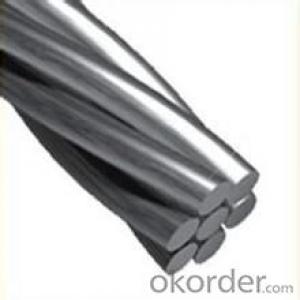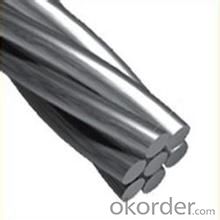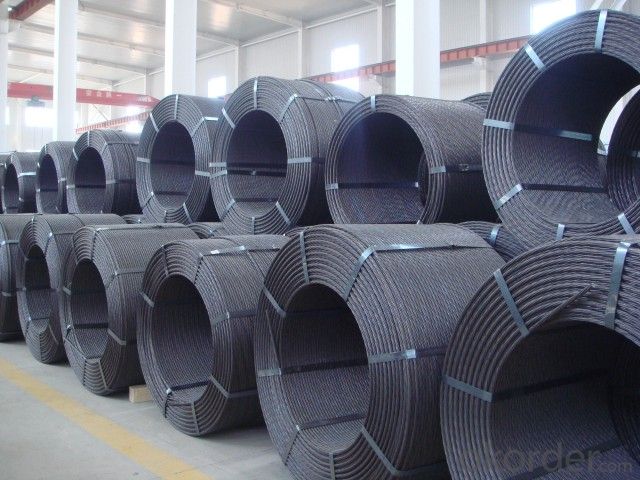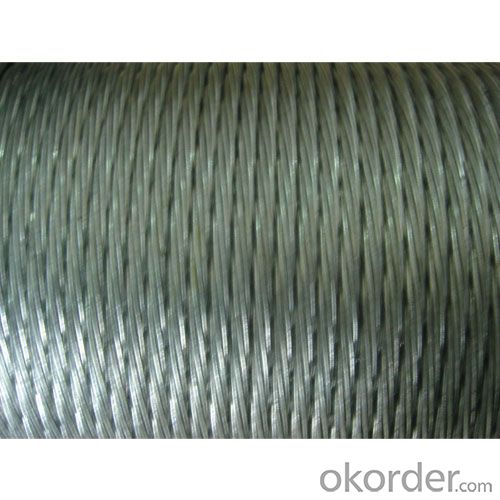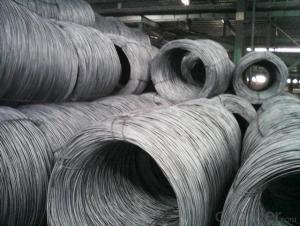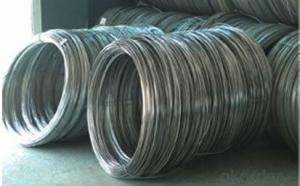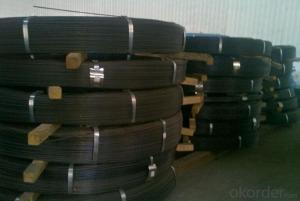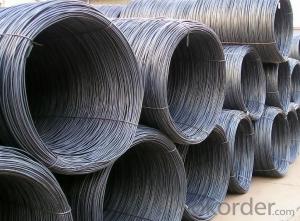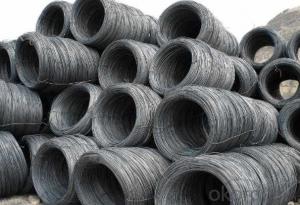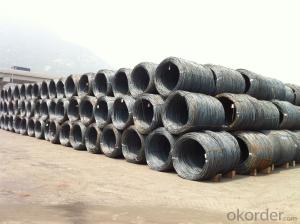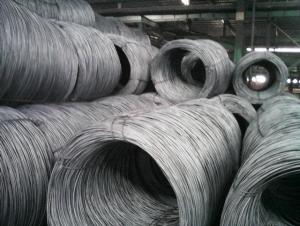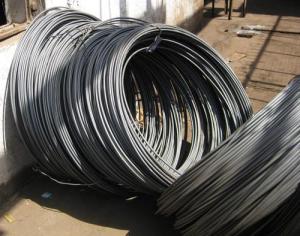Buy Wholesale From China bs5896 pc steel strand
- Loading Port:
- Tianjin
- Payment Terms:
- TT OR LC
- Min Order Qty:
- 50 m.t.
- Supply Capability:
- 6000 m.t./month
OKorder Service Pledge
OKorder Financial Service
You Might Also Like
Quick Details
Steel Grade: High carton steel wire 82B
Standard: BS
Wire Gauge: 1*7 - 15.2mm
Place of Origin: Tianjin, China (Mainland)
Type: Drawn Wire
Application: Construction
Alloy Or Not: Non-alloy
Special Use: Cold Heading Steel
Model Number: 1*7-15.2mm
- Commodity: Prestressed Concrete Steel Strand
Strand diameter: 15.2mm
Steel area: 143.4㎡
Unit mass: 1126kg/km
Lay Direction: Left
low relaxation: 3.5%1000h
at Yield strength (1%Ex): 234.6KN
Breaking strength: 260.7KN
Elongation in(Lo>24''/610m: 5.0
Modulus of elasticity: 199
Packaging & Delivery
| Packaging Details: | Packing: In soft coils, water proof paper inner, white color hessian (or. P.P) cloth outer Coil Weight: around 2.500 kg or negotiation Cargo: to be stuffed in 25*20GP containers (No more than 25MTS / container) |
|---|---|
| Delivery Detail: | 20 days after confirm the order |
| Buy Wholesale From China bs5896 pc steel strand |
Product Pictures of bs5896 pc steel strand
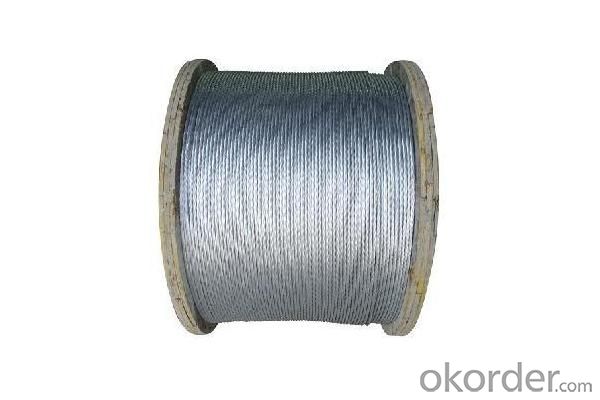
- Q: What are the common manufacturing defects found in steel wire rod?
- Some common manufacturing defects found in steel wire rods include surface cracks, inclusions (foreign materials trapped within the metal), uneven or improper coating, incorrect dimensions or shape, and non-uniform hardness or strength.
- Q: What are the different types of steel wire rod coatings used for increased hardness?
- To enhance the hardness of steel wire rods, various coatings are utilized. These coatings are applied to the surface of the wire rod to augment its strength, durability, and resistance to wear. Some commonly employed coatings are as follows: 1. Galvanized Coating: Widely used, this coating involves the application of a zinc layer to the wire rod through hot-dip or electroplating techniques. The zinc coating offers excellent corrosion resistance and increases the wire rod's hardness. 2. Zinc-Aluminum Coating: By combining zinc and aluminum, this coating provides improved hardness and corrosion resistance. It is applied using a hot-dip process, resulting in a more durable and long-lasting coating compared to regular galvanized coatings. 3. Copper Coating: Copper coatings enhance the wire rod's hardness and electrical conductivity. This type of coating finds common use in electrical wiring and grounding applications where electrical conductivity is essential. 4. Nickel Coating: Renowned for their exceptional hardness and corrosion resistance, nickel coatings are often applied to steel wire rods used in high-stress applications requiring wear resistance, such as springs, cables, and fasteners. 5. Chrome Coating: To increase the hardness and wear resistance of steel wire rods, chrome coatings are employed. This process entails electroplating the rod with a layer of chromium, which exhibits excellent resistance to abrasion and corrosion. 6. Ceramic Coating: A relatively new addition to steel wire rod coatings, ceramic coatings consist of ceramic particles applied to the rod's surface using specialized techniques like plasma spraying. These coatings offer outstanding hardness, wear resistance, and thermal stability, making them ideal for demanding applications like cutting tools and industrial machinery. It should be noted that selecting the appropriate coating for a specific application relies on factors such as intended use, environmental conditions, and desired performance characteristics. Seeking guidance from a materials engineer or coating specialist would be advantageous in determining the most suitable coating for increased hardness in steel wire rods.
- Q: How are steel wire rods packaged and shipped?
- To ensure the safety and integrity of steel wire rods during transportation, a specific packaging and shipping process is followed. This process consists of several steps. Firstly, steel wire rods are typically bound together using steel straps or wires. This bundling process ensures that the rods stay aligned and tightly secured, preventing any potential movement or damage while in transit. Furthermore, it helps maintain the shape and structure of the rods. Once bundled, the steel wire rods are loaded onto pallets or wooden skids. These pallets provide a stable base and allow for easy handling with forklifts or cranes. The rods are carefully placed on the pallets, ensuring proper balance to evenly distribute the weight. After being loaded onto pallets, the steel wire rods are often wrapped with stretch film or other protective material. This wrapping not only secures the rods to the pallet but also shields them from moisture, dust, and other environmental factors during transportation. Additionally, to enhance protection, steel wire rods may be packaged in wooden crates or steel frames. These additional packaging options provide an extra layer of security, safeguarding the rods against potential damage during handling and transportation. Once properly packaged, the steel wire rods are ready for shipping. Depending on factors such as destination and volume, they can be transported via trucks, trains, ships, or airplanes. The choice of transportation method is determined by considerations such as distance, cost, and urgency. During shipping, it is crucial to handle the packaged steel wire rods with care. Appropriate equipment should be used for loading and unloading to minimize the risk of damage. Furthermore, the packages must be adequately secured within the transportation vehicle to prevent any movement or shifting during transit. In conclusion, the packaging and shipping of steel wire rods involve bundling, palletizing, wrapping with protective material, and potentially using additional packaging such as crates or frames. The packaged rods are then transported through various means, ensuring proper handling and security to maintain their quality and integrity.
- Q: What are the main factors influencing the choice of steel wire rod order payment method options?
- The main factors influencing the choice of steel wire rod order payment method options include the financial stability and trustworthiness of the buyer and seller, the volume and frequency of orders, the level of risk involved, the availability of financing options, the buyer's creditworthiness, and any contractual obligations or industry standards.
- Q: What are the main factors influencing the choice of steel wire rod order storage tracking options?
- There are several main factors that influence the choice of steel wire rod order storage tracking options. Firstly, the size and complexity of the storage facility play a significant role in determining the tracking options. If the facility is large and has multiple storage areas or racks, it becomes essential to have a comprehensive tracking system that can accurately locate and monitor each order of steel wire rod. Secondly, the frequency and volume of incoming and outgoing orders also impact the choice of tracking options. If the facility handles a high volume of orders on a regular basis, a real-time tracking system that provides instant updates on the status and location of each order becomes crucial for efficient operations. Thirdly, the level of automation in the storage facility is another factor to consider. If the facility is highly automated, with robotic systems handling the movement and storage of steel wire rod, the tracking options should integrate seamlessly with the automation system to ensure accurate and synchronized tracking of orders. Additionally, the specific requirements and preferences of the customers and suppliers can influence the choice of tracking options. Some customers may require real-time updates and visibility into the status of their orders, while others may prioritize cost-effectiveness or simplicity. Similarly, suppliers may have their own tracking systems in place, which need to be compatible with the storage facility's tracking options. Lastly, the overall budget allocated for implementing and maintaining the tracking system is an important consideration. More advanced tracking options, such as RFID or barcode systems, may require higher upfront investment and ongoing maintenance costs. Therefore, the financial resources available will impact the chosen tracking options. In conclusion, the choice of steel wire rod order storage tracking options is influenced by factors such as the size and complexity of the storage facility, the frequency and volume of orders, the level of automation, customer and supplier requirements, and budget constraints. By carefully considering these factors, an appropriate tracking system can be selected to streamline operations and enhance efficiency in managing steel wire rod orders.
- Q: Can steel wire rod be used in high-temperature applications?
- Steel wire rod can be used in high-temperature applications, but it is important to consider the specific type of steel used and the temperatures involved. Certain grades of steel, such as stainless steel or heat-resistant alloys, are specifically designed to withstand high temperatures without significant loss of strength or structural integrity. These types of steel are often used in industries such as aerospace, automotive, and power generation, where exposure to high temperatures is common. However, not all steel wire rods are suitable for high-temperature applications. Some lower-grade steels may experience a decrease in mechanical properties, such as tensile strength, ductility, and corrosion resistance, when exposed to elevated temperatures. It is crucial to consult the manufacturer's specifications or seek expert advice to determine if a particular steel wire rod is appropriate for the intended high-temperature environment. Additionally, other factors such as the operating conditions, duration of exposure, and presence of other corrosive elements or chemicals should be taken into account when considering the use of steel wire rod in high-temperature applications. Regular monitoring and maintenance may be necessary to ensure the continued performance and safety of the steel wire rod in such environments.
- Q: How is the cleanliness of steel wire rod assessed?
- The cleanliness of steel wire rod is typically assessed through various inspection and testing methods. These may include visual examination, ultrasonic testing, magnetic particle inspection, and chemical analysis. These techniques help evaluate the presence of surface defects, inclusions, and impurities in the wire rod, ensuring its quality and suitability for various applications.
- Q: What are the common industry trends for steel wire rod?
- Some common industry trends for steel wire rod include an increasing demand for high-quality, environmentally friendly and sustainable products. There is also a growing focus on automation and digitalization in manufacturing processes to improve efficiency and reduce costs. Additionally, the industry is experiencing a shift towards using advanced alloys and specialized wire rod products for specific applications such as automotive, construction, and energy sectors.
- Q: How is steel wire rod used in the production of tire reinforcement materials?
- Steel wire rod is used in the production of tire reinforcement materials as it provides strength and durability to the tires. The wire rod is typically twisted or braided together to form steel cords, which are then embedded in the tire's rubber compound. These steel cords help to improve the tire's strength, stability, and resistance to punctures, ensuring a safer and more reliable performance on the road.
- Q: What are the standard hardness requirements for steel wire rod?
- The standard hardness requirements for steel wire rod can vary depending on the specific application and industry standards. However, in general, steel wire rod is commonly required to have a hardness of around 100-300 HB (Brinell hardness) or 10-30 HRC (Rockwell hardness). These hardness requirements ensure the wire rod's strength and durability for various purposes, such as manufacturing springs, cables, and reinforcing materials.
Send your message to us
Buy Wholesale From China bs5896 pc steel strand
- Loading Port:
- Tianjin
- Payment Terms:
- TT OR LC
- Min Order Qty:
- 50 m.t.
- Supply Capability:
- 6000 m.t./month
OKorder Service Pledge
OKorder Financial Service
Similar products
Hot products
Hot Searches
Related keywords
